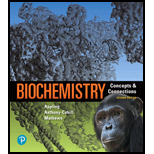
Concept explainers
Interpretation:
The temperature at which the unfolding of lysozyme become favorable should be determined.
Concept Introduction:
Entropy changes can be determined by using enthalpy changes and standard free energy changes values. The Gibbs energy change can be defined as the difference between the enthalpy of the system and product of the temperature and entropy of the system. The value of standard Gibbs energy change also helps in predicting the spontaneity of a reaction, that whether the reaction favorable or not.
Explanation of Solution
If
The folding starts when
Thus,
So, above
Interpretation:
The temperature at which the ratio of unfolded protein to protein becomes 1:5 should be determined.
Concept Introduction:
Entropy changes can be determined by using enthalpy changes and standard free energy changes values. The Gibbs energy change can be defined as the difference between the enthalpy of the system and product of the temperature and entropy of the system. The value of standard Gibbs energy change also helps in predicting the spontaneity of a reaction, that whether the reaction favorable or not.
Explanation of Solution
We will now substitute the value of Gibbs energy change in the above equation. But, we will also reverse the sign as protein is going from an unfolded state to a folded state. So, the equation becomes as
Now, we will calculate T as
Changing the value of
Thus, the temperature at which the ratio of unfolded protein to protein becomes 1:5 is 12.31 K.
Want to see more full solutions like this?
Chapter 3 Solutions
Biochemistry: Concepts and Connections Plus Mastering Chemistry with Pearson eText -- Access Card Package (2nd Edition) (What's New in Biochemistry)
 BiochemistryBiochemistryISBN:9781319114671Author:Lubert Stryer, Jeremy M. Berg, John L. Tymoczko, Gregory J. Gatto Jr.Publisher:W. H. Freeman
BiochemistryBiochemistryISBN:9781319114671Author:Lubert Stryer, Jeremy M. Berg, John L. Tymoczko, Gregory J. Gatto Jr.Publisher:W. H. Freeman Lehninger Principles of BiochemistryBiochemistryISBN:9781464126116Author:David L. Nelson, Michael M. CoxPublisher:W. H. Freeman
Lehninger Principles of BiochemistryBiochemistryISBN:9781464126116Author:David L. Nelson, Michael M. CoxPublisher:W. H. Freeman Fundamentals of Biochemistry: Life at the Molecul...BiochemistryISBN:9781118918401Author:Donald Voet, Judith G. Voet, Charlotte W. PrattPublisher:WILEY
Fundamentals of Biochemistry: Life at the Molecul...BiochemistryISBN:9781118918401Author:Donald Voet, Judith G. Voet, Charlotte W. PrattPublisher:WILEY BiochemistryBiochemistryISBN:9781305961135Author:Mary K. Campbell, Shawn O. Farrell, Owen M. McDougalPublisher:Cengage Learning
BiochemistryBiochemistryISBN:9781305961135Author:Mary K. Campbell, Shawn O. Farrell, Owen M. McDougalPublisher:Cengage Learning BiochemistryBiochemistryISBN:9781305577206Author:Reginald H. Garrett, Charles M. GrishamPublisher:Cengage Learning
BiochemistryBiochemistryISBN:9781305577206Author:Reginald H. Garrett, Charles M. GrishamPublisher:Cengage Learning Fundamentals of General, Organic, and Biological ...BiochemistryISBN:9780134015187Author:John E. McMurry, David S. Ballantine, Carl A. Hoeger, Virginia E. PetersonPublisher:PEARSON
Fundamentals of General, Organic, and Biological ...BiochemistryISBN:9780134015187Author:John E. McMurry, David S. Ballantine, Carl A. Hoeger, Virginia E. PetersonPublisher:PEARSON





